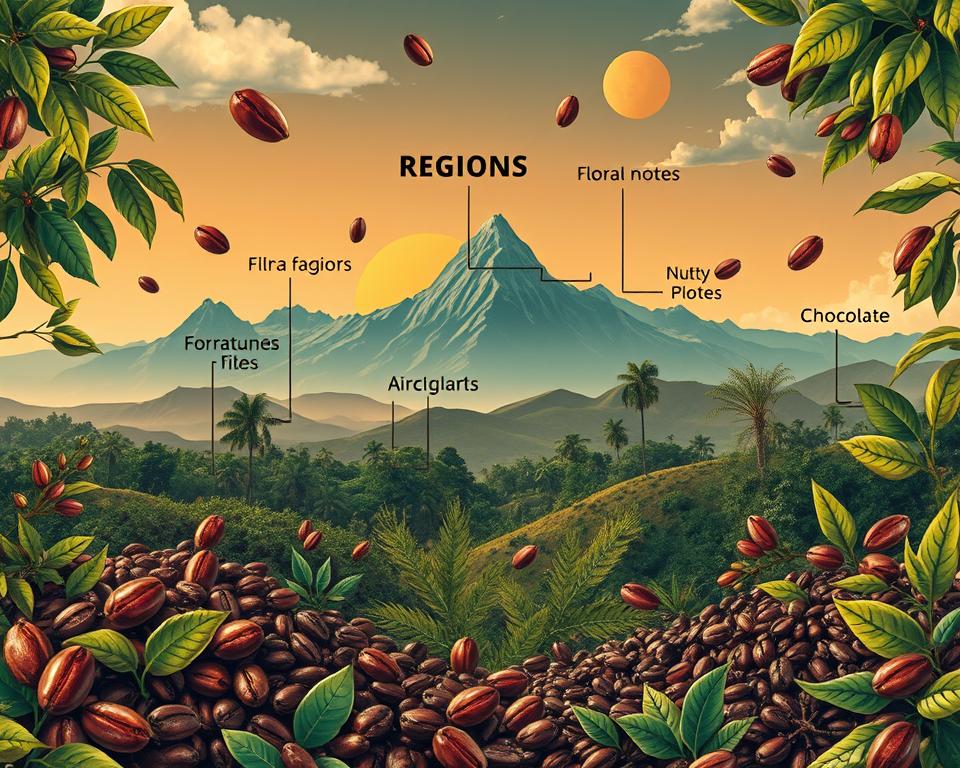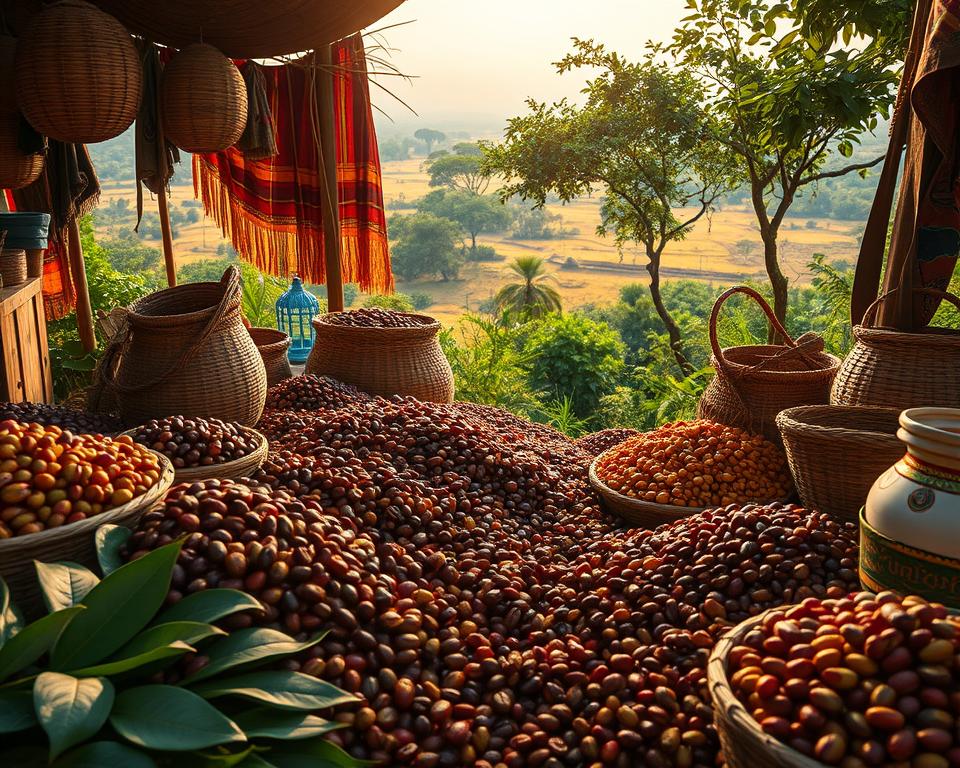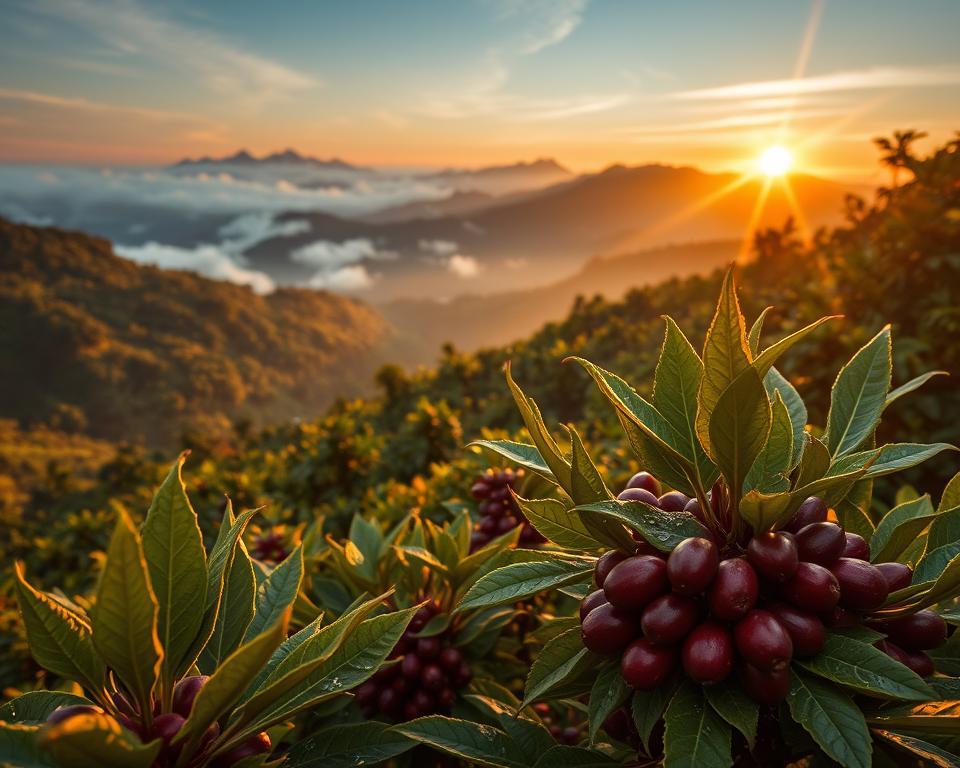Welcome to an exciting coffee tasting adventure! We’re starting a journey into the world of regional coffee varieties. Our exploration will reach across continents, revealing more than just regular coffee blends found in stores.
With our guide, Tom from batchcoffee.co.uk, let’s discover tastes that match your liking. We’ll experience the gentle, floral flavors of Ethiopian beans and the strong, earthy vibes of Sumatran coffee. Our journey through global coffee profiles offers a wide range of flavors to explore. Dive into the unique characteristics that make specialty coffees stand out.
Learning about regional coffee varieties is not just for experts. It’s a rewarding journey for any coffee enthusiast looking to improve their daily coffee ritual. Let’s start this captivating journey and find the coffee flavors that enchant our senses!
Introduction to Coffee Flavor Profiles
Exploring coffee starts with understanding coffee flavor profiles. These profiles showcase the unique tastes of coffee beans. They are shaped by where the beans come from, the climate, and the soil.
Learning about these profiles helps enjoy the variety in coffee flavors. It also aids in choosing a coffee that suits your taste. For example, knowing the difference between the fruity flavor of an African coffee and the nutty taste of a South American blend enriches your coffee experience.

Definition of Coffee Flavor Profiles
Coffee flavor profiles are the mix of tastes that make each coffee unique. They result from the coffee’s origin, environmental conditions, and how the beans are grown and processed. It’s key for diving into the world of coffee and understanding what sets each one apart.
Importance of Understanding Coffee Origins
Knowing where coffee comes from is crucial for recognizing its flavors. For instance, Central American coffees like those from Guatemala are nutty and sweet. While Nicaraguan coffees have bold and caramel notes.
South American beans, from Brazil and Colombia, boast espresso-worthy flavors with low acidity and hints of cocoa. Meanwhile, Ethiopian and Kenyan coffees offer fruity flavors, thanks to the high-altitude growing conditions. This knowledge is essential for appreciating the rich variety of coffee tastes.
African Coffee Flavor Profiles
Africa is known as the birthplace of coffee. It provides unique and diverse coffee experiences. The continent produces 12 percent of the world’s coffee. In 2023, African coffee made an impressive $15 billion globally.

Ethiopian Coffee
Ethiopia is Africa’s top coffee producer and fifth worldwide. In 2023, it exported 8.3 million 60-kilogram bags. Ethiopian coffee is famous for its wide range of flavors, thanks to its genetic diversity.
The Yirgacheffe region’s coffee is bright and complex. It has floral and fruit-forward notes. This flavor profile makes Ethiopian coffee loved worldwide.
Kenyan Coffee
In 2023, Kenya exported 800,000 60-kilogram bags. Kenyan coffee is full-bodied and has bright acidity. A special grading system ensures the highest quality.
Flavors often include blackberries and tomatoes. Only 5-10 percent of Kenya’s coffee is the rare Peaberry variety. This makes it extra special for coffee fans.
Tanzanian Coffee
Coffee accounts for 20 percent of Tanzania’s exports. Most of it comes from small farmer cooperatives. Tanzanian coffee is balanced, with fruit and sweet flavors.
It’s known for being bright, clean, and medium-bodied. Tanzanian coffee is liked for its distinct flavor. It offers a unique African coffee experience.
Ugandan Coffee
Uganda exported 6.8 million 60-kilogram bags in 2023. It’s the sixth-largest exporter globally. Ugandan coffee is robust, with chocolate and nut hints.
It might be less famous than Ethiopian or Kenyan coffee. Yet, Ugandan coffee has a rich flavor that many enjoy. It’s a key part of Africa’s coffee legacy.
For a great homemade coffee treat, check this coconut creamer for coffee recipe.
Central American Coffee Flavor Profiles
Central America is known for its unique coffee flavors. These flavors come from rich volcanic soils and diverse altitudes. Each country offers distinct and delightful coffee experiences for aficionados.
Guatemalan Coffee
Guatemala has eight main coffee regions. Each has its own distinct roast qualities. The coffee is grown at altitudes between 1,300 and 2,000 meters. It mainly includes Arabica varieties like Typica and Bourbon.
German immigrants in the 19th century brought their coffee expertise to Guatemala. The country’s fertile soil and climate help produce deep flavors. Guatemalan coffee tastes range from sweet and nutty to spicy.
Nicaraguan Coffee
Nicaragua’s coffee industry thrives despite political challenges. It produces beans with various flavor profiles from different regions. Nicaraguan coffee is known for its boldness and hints of chocolate and caramel.
Costa Rican Coffee
Costa Rican coffee is celebrated for its high and bright notes. It features a balanced body and acidity. The coffee industry is vital to Costa Rica, making up about 25% of its earnings.
The country has around 400 million coffee trees. They produce approximately 1,700 kilograms of coffee per hectare. Costa Rica makes about 1.5 million bags of coffee a year. This highlights coffee’s significant role in its economy.
Mexican Coffee
Mexico is the fourth-largest coffee producer in the world. It leads in certified organic beans production. The industry relies on smallholder farmers.
Mexican coffee is diverse. Beans from Chiapas often have chocolatey notes with a hint of spice. This mix makes Mexican coffee unique and popular worldwide.
South American Coffee Flavor Profiles
Starting a South American coffee tour opens up a world of unique tastes. This journey through renowned coffee regions offers distinct flavors. Each region’s coffee is celebrated for its own special taste.
Brazilian Coffee
In Brazil, coffee beans have a nutty sweetness and a smooth character. They are perfect for espresso blends because of their chocolaty finish. Also, their low acidity makes them ideal for those who like a rich cup without a sharp tang.
Colombian Coffee
Colombian coffee stands out with its perfect balance of acidity and caramel flavors. It surprises with a touch of fruitiness. This complex taste makes Colombian coffee great for different brewing methods.
Peruvian Coffee
Peru’s Andean highlands give us beans with a sweet, gentle profile and a light body. These beans offer smooth flavors with nutty and sweet hints. This makes Peruvian coffee a top pick for a refined taste.
Bolivian Coffee
Bolivian coffee is known for its lively acidity and rich, chocolatey depth. Bolivia’s unique conditions add to the coffee’s special profile. It delivers a bold yet sophisticated cup.
Each part of the South American coffee tour brings a new experience. From Brazilian bean flavors to Colombian coffee characteristics, there’s a flavor for everyone. Explore South America’s coffee, one cup at a time.
Asian Coffee Flavor Profiles
Exploring Asian coffee opens a world of flavors. It offers vibrant and diverse tastes. Coffee lovers will find these flavors surprising and delightful.
Indonesian coffee is a standout. It comes from the Western Highlands with earthy and herbal notes. Java coffee is famous for its heavy body and low acidity. It also has floral and spicy notes. Sumatran Mandheling and Aceh coffees offer bold tastes. Mandheling has a complex body and low acidity. Aceh coffee is known for its earthy, woody, and herbal flavors.
Vietnam’s coffee scene is impressive. The coffee has a rich, chocolatey taste with a smoky hint. This combination makes the coffee experience unforgettable.
Indian coffee varies from subtle to bold flavors. Karnataka coffee is known for its balanced flavor. It mixes nutty and spicy notes. Kerala coffee is sweet and mellow, with chocolaty undertones and nutty accents. These Indian coffees offer a delightful flavor exploration.
In the Philippines, the coffee has unique profiles. These coffees are a blend of fruity, nutty, and floral notes. They reflect the lush landscapes of the Philippines.
The journey of discovering Asian coffee is rich and varied. With flavors from Indonesia, Vietnam, India, and the Philippines, each cup tells a story. It’s a narrative of culture, nature, and skillful cultivation.
Impact of Coffee Processing Methods on Flavor Profiles
Exploring different coffee processing methods opens up a world of tastes. Each method shapes the coffee’s flavor in unique ways. By understanding these methods, we learn to enjoy the wide range of tastes in our coffee.
Washed or Wet Processed Coffee
Washed coffee has a clear, lively taste. The beans ferment in tanks for 12-48 hours, then get washed. This leads to bright flavors and more acidity. These beans are crisp and can taste fruity or floral. They do well in volcanic soil areas like Guatemala and Costa Rica.
Natural or Dry Processed Coffee
Natural coffee is known for its strong berry and tropical fruit flavors. The beans dry with the cherry for 2-4 weeks. This makes the coffee body richer and the taste sweeter. The result is a deeply complex and rich flavor.
Honey Processed Coffee
Honey processed coffee offers sweetness and body variations. Beans dry with some mucilage left on them. This method is between washed and natural. It provides a balance of acidity and sweet, caramel-like tastes. This makes it popular in some Brazilian parts.
Monsooned Processed Coffee
Monsooned coffee comes from a unique process in India. Beans are exposed to monsoon winds for weeks. This reduces their acidity and increases body. The result is a coffee that’s full-bodied with a musty, earthy taste and chocolate notes. This process gives monsooned coffees a unique flavor.
How Does Climate Influence the Regional Coffee Flavor Profiles?
The unique characteristics of coffee flavor are profoundly shaped by factors such as altitude, soil, and notably, climate’s role in coffee taste. Variations in rainfall and temperature influence the growth cycle, leading to distinct acidity, sweetness, and body in beans, ultimately defining the regional profiles enjoyed by coffee aficionados.
Conclusion
Coffee is more than just a drink. It’s a story that spans the globe, with each region offering its unique taste. We’ve explored coffees from Africa, Central America, South America, and Asia. Each place adds its own touch to the world of coffee.
Coffees grown at high altitudes, like in Ethiopia and Colombia, have complex flavors with fruity and floral notes. Lower altitude coffees, such as those from Brazil, are smoother with nutty and chocolatey tastes. Understanding these differences helps us enjoy our coffee more.
The type of soil, like Guatemala’s volcanic or others rich in organic matter, affects coffee’s taste. The way coffee is processed also impacts its flavor. For example, washed, natural, or honey-processed coffees offer different tastes. This mix of sweetness, acidity, and unique notes like fruity or nutty, shows coffee tasting is both science and art.
Learning about coffee’s diverse flavors can turn anyone into a connoisseur. It makes our daily coffee routine more exciting. Let’s keep exploring the world of coffee, one delicious cup at a time.
FAQ
What are coffee flavor profiles?
Coffee flavor profiles highlight the subtle and varied tastes of coffee beans. They’re defined by where the beans come from. This includes the climate, soil, and other unique conditions of each region.
Why is understanding coffee origins important?
Knowing coffee origins helps us enjoy the wide range of flavors in coffee. It lets you choose coffees that match what you like.
What makes Ethiopian coffee unique?
Ethiopian coffee is special because of its wide range of flavors. From floral to fruit-forward tastes, it’s where coffee cherries first came from.
How is Kenyan coffee described?
Kenyan coffee is full-bodied and bright in acidity. Its flavors can remind you of blackberry and even tomato.
What are the typical flavor notes in Tanzanian coffee?
Tanzanian coffee is known for being balanced. It has fruity and sweet hints.
What distinguishes Ugandan coffee?
Ugandan coffee is known for its robustness. It has chocolate and nutty flavors.
What are the key characteristics of Guatemalan coffee?
Guatemalan coffee has deep, complex flavors. These range from sweet and nutty to spicy. It’s thanks to the rich volcanic soil and various altitudes.
How does Nicaraguan coffee generally taste?
Nicaraguan coffee is bold. You might taste chocolate and caramel in it.
What makes Costa Rican coffee stand out?
Costa Rican coffee has high, bright notes. It’s balanced in body, making it harmonious in flavor.
What are the flavor notes in Mexican coffee?
Mexican coffee, especially from Chiapas, might offer chocolatey flavors. There are also subtle spice undertones.
How would you describe Brazilian coffee?
Brazilian coffee is often nutty and sweet. It’s known for being mellow with a chocolaty finish.
What defines the taste of Colombian coffee?
Colombian coffee balances acidity well. It’s rich in caramel and sometimes has a hint of fruitiness.
What are the typical flavor notes of Peruvian coffee?
Peruvian coffee is often gentler but still sweet. Its body is on the lighter side.
How does Bolivian coffee taste?
Bolivian coffee typically has bright acidity. It also has a rich, chocolatey depth.
What flavors can one expect from Indonesian coffee?
Indonesian coffee is known for its deep earthy and herbal tones.
How is Vietnamese coffee described?
Vietnamese coffee is darker and bolder. It’s rich with chocolate and smokey backgrounds.
What are common flavor notes in Indian coffee?
Indian coffees vary. They can have subtle spice or bold berry-like flavors.
What is washed or wet processed coffee?
Washed coffee has a clean taste. This is because the fruit around the bean is removed before it dries. This makes its flavor clearer.
What are the characteristics of natural or dry processed coffee?
Natural coffees have a richer body. They’re sweeter and fruitier since they dry inside the cherry.
What is honey processed coffee?
Honey processed coffee is sweet and has a varied body. It’s a mix between washed and natural coffees, depending on how much fruit is left on the bean when drying.
What is monsooned processed coffee?
Monsooned coffee ages in India’s monsoon winds. It results in a heavy body with musty, and bold chocolate notes.




